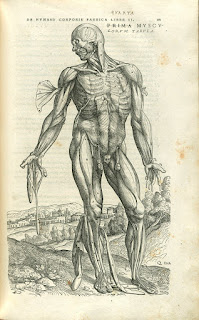Week 4: Medical Technology + Art
The term medical technology is deceptive in it's connection to art for two reasons, the first being that technology makes it seem as though this connection is recent, within the past 100 years or so. The second is that, when looked at on the surface, the medical field and art come across as two disparate fields of study. What most people don't realize is that medicine and art have a long, overlapping history, dating back to the Renaissance and even to ancient Greece and the Hippocratic Oath. In fact, during the Renaissance, artists worked hand in hand with doctors who were dissecting the human body in order to accurately capture the body and what the doctors were finding.
 |
| Example of anatomical art drawing by Vesalius who worked during the 1500's. |
This long, intertwined history between medical technology and art continues to this today. In fact, artists such as Diane Gromala, who used virtual reality and MRI's of her own body to create a 3D journey through the body, are living proof of it. The video below is just one of the many examples of virtual reality tours though the human body that are available today.
But, the connection between medical technology and art goes beyond virtual reality and models. It can be seen in the way that doctors image and map the human body, not just in the pictures they take of the body but the sounds and sensations that accompany generating them.
To me, the pinnacle of the connection between the two areas can be seen in the prosthetics. On the one hand, prosthetics were created for a very medical purpose and are need to be anatomically and proportionally correct.
But, on the other hand, prosthetics had to be developed and refined. In addition to be anatomically correct, they also need to be aesthetically pleasing and mimic the shape and look a real arm. So, in this sense, art comes in to play in the design process. Furthermore, the development and of a prosthetic incorporates more that just the visual sense in the sounds it makes as it moves, the way it feels, and the sensations it evokes for the user.
 |
| Example of a cutting edge prosthetic arm, made to reflect human anatomical proportions. |
But, on the other hand, prosthetics had to be developed and refined. In addition to be anatomically correct, they also need to be aesthetically pleasing and mimic the shape and look a real arm. So, in this sense, art comes in to play in the design process. Furthermore, the development and of a prosthetic incorporates more that just the visual sense in the sounds it makes as it moves, the way it feels, and the sensations it evokes for the user.
Sources:
Vesna, Victoria. “Medicine Part 1.” DESMA 9. Lecture.
Gromala, Diane. “Curative Powers of Wet, Raw Beauty.” Tedx. 7 Dec 2011. Web.
Tyson, Peter. “The Hippocratic Oath Today.” PBS. 27 Mar. 2001. Web.
“Vesalius’s Renaissance Anatomy Lessons.” British Library. Web. http://www.bl.uk/learning/cult/bodies/vesalius/renaissance.html
“Journey Through the Human Body in 3D Flight & Motion Simulation.” Youtube, uploaded by Geigerfilm, 17 Mar 2012. https://www.youtube.com/watch?v=eXQgPCsd83c
Summers, Nick. “Prosthetic Arms Inspired by Deus Ex are Coming Next Year.” Engadget, 8 June, 2016. Web.

I like how you touched upon how art and medicine interact in increasingly advanced ways that ultimately help the patient (i.e. prosthetics). I actually have an acquaintance who has a prosthetic hand that is extremely sophisticated, aesthetically pleasing, and exceptionally functional - whatever technology was used allowed the hand to really function almost as if he had never lost his actual hand. So it's interesting having witnessed this union in real life and to see how far technology - with the help of art - has come, especially in the medical field.
ReplyDelete